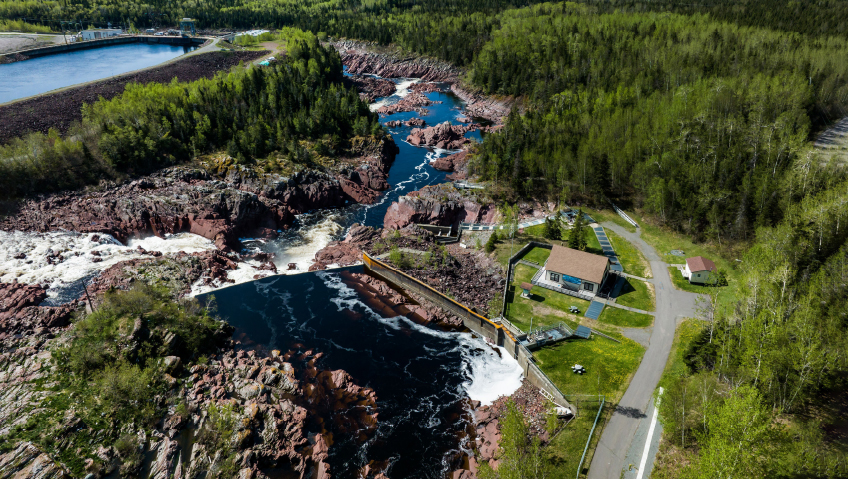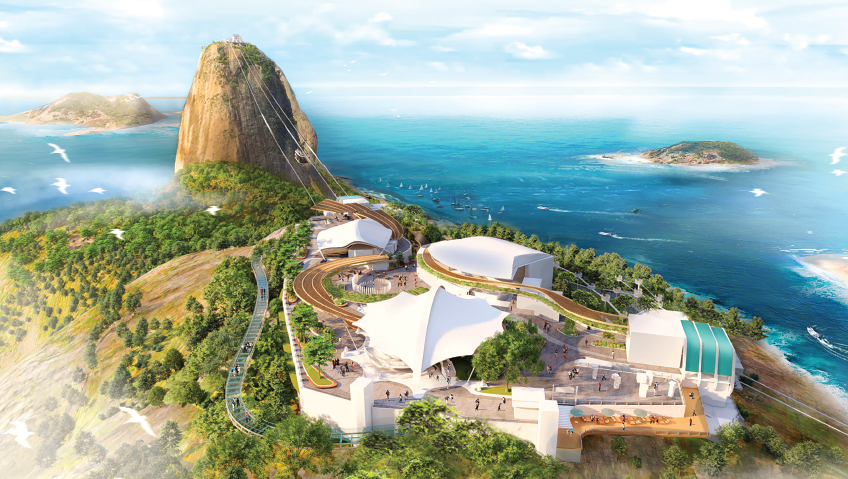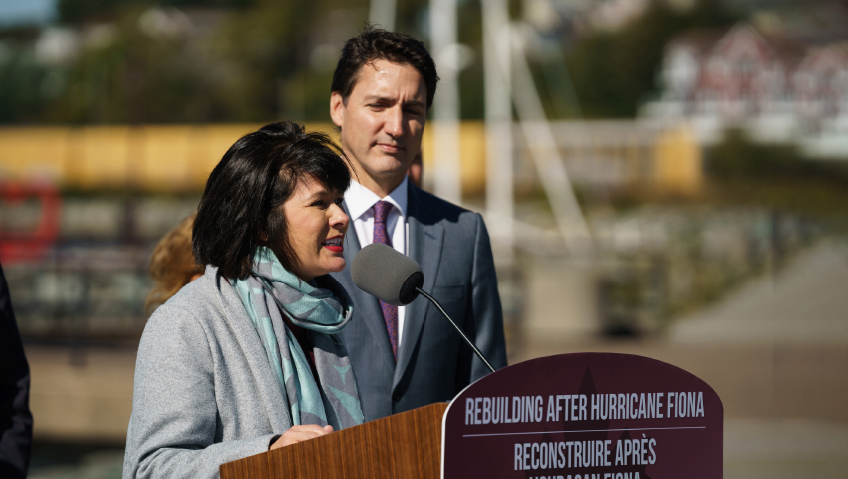Grand Falls–Windsor, centrally located on the island of Newfoundland, is a welcoming, family-oriented, business-friendly community with much to offer residents and visitors alike.
We recently enjoyed a wide-ranging conversation with Mike Browne, Deputy Mayor of Grand Falls-Windsor since 2016, and Lawrence Ducey, the town’s Economic Development Manager since 2020, both of whom radiate enthusiasm for their hometown. “I’ve lived here all my life and I would never want to live anywhere else,” says Browne.
Ducey agrees, noting that the population of the town (13,853 in the 2021 census along with 80,000 in the catchment area that it services) has been steadily growing, as others recognize what Browne and Ducey know—that Grand Falls-Windsor is a great place to live and work.
“The town is perfectly centred here on the island,” Ducey says, referring to its location in the beautiful Exploits River Valley, mid-point on the nine-hour Trans-Canada Highway journey between Port aux Basques on the west coast and the capital, St. John’s, on the east, and an hour from Gander International Airport.
In addition, there are good provincial road connections to small communities on Newfoundland’s south coast, with its flourishing aquaculture industry; to the interior with its mining operations; and to the deep-water port at Botwood on the north coast.
Unique history
Grand Falls and the neighbouring town of Windsor, which were amalgamated in 1991, quite literally sprang to life in the first decade of the 20th century.
In 1902, representatives of the London Daily Mail, drawn by the area’s rich supply of softwood lumber, the proximity of the Newfoundland Railway, the nearby deep-water port, and the potential of hydroelectricity from the falls, established Newfoundland’s first pulp and paper mill, which began producing newsprint in 1909.
The province didn’t join Confederation until 1949, so it was still a British colony when the Anglo Newfoundland Development Company was formed to manage the mill and develop the town in 1905, based on the Garden City Movement. This was an urban planning project proposed by Ebenezer Howard in 1898 in England to capture the best features of both rural and urban living while avoiding the disadvantages.
In addition to providing employment and designing an attractive community, which included paved roads—a first in Newfoundland—the company believed it was important to cater to the social, athletic, and spiritual needs of the residents. It established an athletic club, sponsored hockey, boxing, golf, and soccer teams, along with musical and amateur theatrical groups, and built churches.
The mill was later acquired by Abitibi Bowater and operated for another hundred years, closing in 2009, when demand for newsprint declined. This resulted in a loss of 450 jobs, which while substantial was not as devastating as it might seem, as many of the employees were aged 55 and older and had worked there for over 30 years, so were eligible for pensions, while some of the younger tradespeople with homes in Grand Falls-Windsor began commuting to work in Alberta.
A dynamic community
Nor did the closure of the pulp mill devastate the viability of the town, for several reasons. The town had already begun a move toward economic diversification with the establishment in 2001 of the EXCITE Corporation (Exploits Centre for Information Technology Excellence) with assistance from ACOA. Its first customer was DPSI, a software company out of Greensboro, North Carolina, which still employs people in the community today.
In addition, the infrastructure that had enabled the town to become a key service centre for a much larger catchment area, with retail, health, education, and recreational services, was already in place. “This meant that residents from outlying communities were still coming into the town, to access goods and services and then return home,” Ducey says, “so there continued to be an ebb and flow, like the Newfoundland tides.”
He recalls that the Town made an effort to identify communities with a similar rural service center profile and proximity to similar industrial sectors—such as aquaculture and mining, which are also active in Central Newfoundland—and one of the models they looked at was the town of Campbell River in British Columbia that became an industrial service centre. “That model made sense to us. We had a strong support sector due to the pulp and paper mill, with amenities, services, and attractions, and surrounding us we had the mining sector and the aquaculture sector, making us a hub for those workers.”
The central location is indeed well-positioned to service the aquaculture industry, which helped to fill the devastating economic gap created when the cod fishery collapsed in 1992; now steelhead trout and Atlantic salmon are farmed on the south coast while a number of blue mussel aquaculture sites are located relatively close to Grand Falls-Windsor, several less than an hour’s drive, in seaside communities along Newfoundland’s northeast coast.
Mines had previously operated in the central area and now the Toronto-based Marathon Gold Mining company has established an office in the industrial park to advance its Valentine Gold Project. This is a series of four mineralized deposits along a 20 km system, 80 km from the town, which is expected to have a 13-year lifespan with production to begin in 2025. “With $305 million invested in constructing the site and $100 million spent annually in goods and services, it will provide 400 direct jobs and 300 spinoffs, and be a significant boost to our economy,” says Ducey.
He is also seeing opportunities to establish a hydroponic plant-growing industry that could improve food security issues. “Our province has recognized that we need to move toward a more plant-based diet and we want to be on the cutting edge,” he says, noting that Papa’s Farms, a family-owned greenhouse operation, uses geothermal and hydroponic technology to grow pesticide-free lettuce year-round. “We are working with the Warford family to expand their facility and grow other green vegetables. Our location as a hub for distribution makes sense.”
Community health research
The EXCITE Corporation, which was formed in 2001 with assistance from the Atlantic Canada Opportunities Agency (ACOA), which remains an integral partner, has proven to be a game changer for the town.
EXCITE’s vision is to establish Grand Falls-Windsor as a rural health innovation hub. “Through partnerships, groundbreaking research, social innovation, and community mobilization, we aim to bring together people and to advance population health.”
The EXCITE Corporation’s partnerships in health and technology include Memorial University, McMaster University, Western University, National Audiology Centre (London, ON), and Central Health, the regional health care authority.
A key initiative of EXCITE is the Genomics-Based Research Centre for Health in partnership with Memorial University Faculty of Medicine. The Centre plays a key role in patient recruitment, assessment, and data collection across multiple projects as researchers collect DNA samples for research into hearing, vision, and heart health. Making the connection between the phenotypes and the genome allows scientists to discover what causes the disease, and knowing this allows them to develop better treatments with industry partners.
As Ducey explains, the founder population of 20,000 European settlers, mainly English and Irish, allows scientists to research genes more easily. “For example, they have already isolated four genes that contribute to hearing loss and that research may lead to further work that improves the effectiveness of hearing aids.”
This exciting research is creating new partnerships with health industry partners. The results include new rural health services that improve the quality of life for people and new economic opportunities in central Newfoundland and Labrador.
The Town of Grand Falls-Winsor is working with local, regional, and provincial stakeholders to create services that promote and enhance community wellness. This involves partnering with many community-based groups around common themes that make Grand Falls-Windsor a liveable community and an important rural health services hub.
In turn, that level of excellent healthcare makes Grand Falls-Windsor a very attractive community for people and businesses considering relocating, promising a better quality of life.
Quality of life
When people think about economic development, they think about job growth and promoting industry, and of course, those are very important components, but both Ducey and Browne agree that there is more to developing a viable community.
“The other side of the coin is that we have to provide amenities and opportunities to support a good quality of life and social well-being,” Ducey says. “As a family-oriented community, we are focused on activities for all ages and abilities, hosting over 200 social events and activities throughout the year including seniors art and social days, baby and me classes, festivals, family days, multicultural days, and sporting events, adding new activities regularly, such as pickle ball and cricket. We partner with others as well, including Central Health in hosting sessions on mental health and TechNL when hosting innovation learning activities for youth. We try to create opportunities for people to manage the ups and downs of daily life. We want people not to have to rely entirely on the system but be engaged with the community and enjoy what we have to offer.”
Adds Browne, “Making Grand Falls-Windsor an active community, is a goal of council. We want to ensure people living here are not bored and feel supported, so we focus on that. Some communities leave it all to non-profit organizations, but as a community, it is one of our priorities.”
The legacy of recreational activities established by the founding mill owners continues to this day. “The town is known for its history of sports, and we have had top hockey and baseball players go on to national teams,” says Browne. “We have two stadiums, swimming pools, golf courses, and areas for track and field.”
Meanwhile, arts and culture are celebrated at the Gordon Pinsent Centre for the Arts, named for the town’s most famous son, the award-winning actor and writer who was born here in 1930. The centre, which was reconstructed from the Czechoslovakian Pavilion at Expo ’67 in Montreal, contains a public library, two art galleries, and a theatre. There are also the Queen Street Dinner Theatre and several commercial galleries.
Angling for Atlantic salmon
Not only is the town itself vibrant, but it is in a stunningly beautiful area on the Exploits River, a class 3 white water-rafting river and one of the few in the world where the Atlantic salmon has been restored.
“Europeans and North Americans find Newfoundland and Labrador to be an exotic destination,” Ducey says. With Grand Falls-Windsor halfway between the capital, St. John’s, and Gros Morne National Park on the northwest tip, the site of an early Viking settlement, it is an ideal stop-over and ACOA has been front and centre assisting with developments for the tourist industry.
Visitors can enjoy a half-day visit to the Salmonid Interpretation Centre and watch salmon jump and swim through the passageway system on the falls. They can purchase a salmon-angling licence or enjoy time exploring the surrounding Gorge Park, which includes walking trails and a zip line over the river, with plans to build a suspension bridge and an amphitheatre. There’s also the Corduroy Brook Nature Trail across the marsh and a groomed cross-country ski trail.
Going forward
“One challenge we have across all sectors is a workforce shortage,” Ducey says. It’s an issue that’s compounded by an ageing population and low immigration numbers, unlike other parts of Canada and the U.S.
“A pillar of our economic development strategy going forward must be a focus on immigration, and we’re really keen on recruiting and welcoming more people from a variety of places, such as India and the Philippines,” he shares.
“We want to make sure there is a strong connection between education and employment in our community, so opportunities are here for existing and new residents to complete studies in such areas as software development and nursing (there are three colleges in town). We want to enable more people to be able study and work right here in Central NL, while providing a pathway to permanent residency for new residents and ensuring all can fully enjoy what Grand Falls-Windsor has to offer.”






